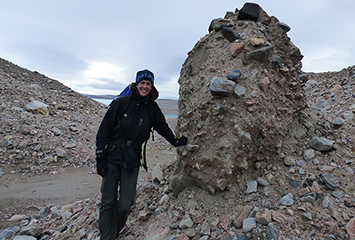 [Evanston, IL.]—Yarrow Axford, assistant professor of earth and planetary sciences at Northwestern University, has been awarded the Faculty Early Career Development (CAREER) Award from the National Science Foundation (NSF) for her research to reconstruct the climate history of Southern Greenland. Axford’s award will total $600,000 over 5 years, with additional support from NSF for field logistics.
[Evanston, IL.]—Yarrow Axford, assistant professor of earth and planetary sciences at Northwestern University, has been awarded the Faculty Early Career Development (CAREER) Award from the National Science Foundation (NSF) for her research to reconstruct the climate history of Southern Greenland. Axford’s award will total $600,000 over 5 years, with additional support from NSF for field logistics.
Considered NSF’s most prestigious award for pre-tenure faculty, the CAREER program recognizes and supports early career development of teacher-scholars who are most likely to become the academic leaders of the 21st century.
“It’s an honor to receive this award, and I’m thrilled to be able to continue working in Greenland. I really believe it’s a critical area of the world for climate change research,” says Axford.
Although researchers know that as global temperatures rise, the ice sheet will shrink, they don’t yet know how quickly that will happen. To better understand this process, Axford’s research team (which includes PhD students Jamie McFarlin and Everett Lasher) has studied reconstructing past climate records of the Greenland Ice Sheet during the early Holocene, a period of time roughly 9,000 to 5,000 years ago when temperatures around most of the Arctic were warmer due to a slow, predictable shift in Earth’s orbit.
“The early Holocene provides an opportunity to see what the Arctic looks like when it gets warmer,” explains Axford. “This time period is one of our best geologic analogs for the future – a warmer world that looks otherwise very much like today.”
The Greenland Ice Sheet – the second largest body of ice in the world—has shown rapid melt in recent decades, and could threaten coastal communities around the world as melting continues.
“To put it into perspective, this two-mile-thick ice sheet contains enough water to raise global sea level by about 22 feet,” says Axford. “So it’s a good idea to try to understand it better than we do right now.”
Over the past six years, Axford has worked on Greenland with support from NSF’s Office of Polar Programs and the Institute for Sustainability and Energy at Northwestern (ISEN).
“Early support, including funding from ISEN, helped me gain the ‘boots-on-the-ground’ experience I needed to get familiar with working in Greenland’s rugged terrain, and then to hone the lab methods that are best suited to reconstructing Greenland’s past,” says Axford.
To map the geologic record of Greenland’s climate during this time period, the team will take sediment cores from deep within numerous remote lakes across southernmost Greenland. From a floating “coring rig”, they will lower a tube holding a piston into the lake until they’ve reached the depth (about 1 to 10 meters for every 10,000 years) that correlates to the time in history they’re studying and pull out a sample.
In the cores they bring back to the lab at Northwestern, Axford’s team will look to three indicators of past climate change: sand and silt spilled out by glaciers reflecting changes in glacier size; species assemblages of temperature-sensitive insects; and a measure of the mass of oxygen in organic remains, which Axford hypothesizes should reflect changes in atmospheric circulation over time.
Their analyses will help reconstruct how temperatures, atmospheric circulation, and glacier size changed in concert in South Greenland during the last time period when the arctic was warmer for an extended period of time.
In addition to her research, Axford’s award will also support mentorship of graduate students, as well as a collaboration with Northwestern’s Office of Stem Education Partnerships (OSEP) to offer year-long climate change workshops for K-12 teachers in the Evanston-Chicago region.
Axford’s first trip to Southern Greenland is scheduled for summer 2016. She and her team will travel to their study sites using a combination of military transport, helicopter rides, and what Axford calls “good, old-fashioned hiking and carrying your stuff.” They hope to collect a first round of samples to evaluate exactly how their proposed methods will work in this new study region, and to then start developing reconstructions of how past climate change unfolded in a warmer Arctic.
 [Evanston, IL.]—Yarrow Axford, assistant professor of earth and planetary sciences at Northwestern University, has been awarded the Faculty Early Career Development (CAREER) Award from the
[Evanston, IL.]—Yarrow Axford, assistant professor of earth and planetary sciences at Northwestern University, has been awarded the Faculty Early Career Development (CAREER) Award from the